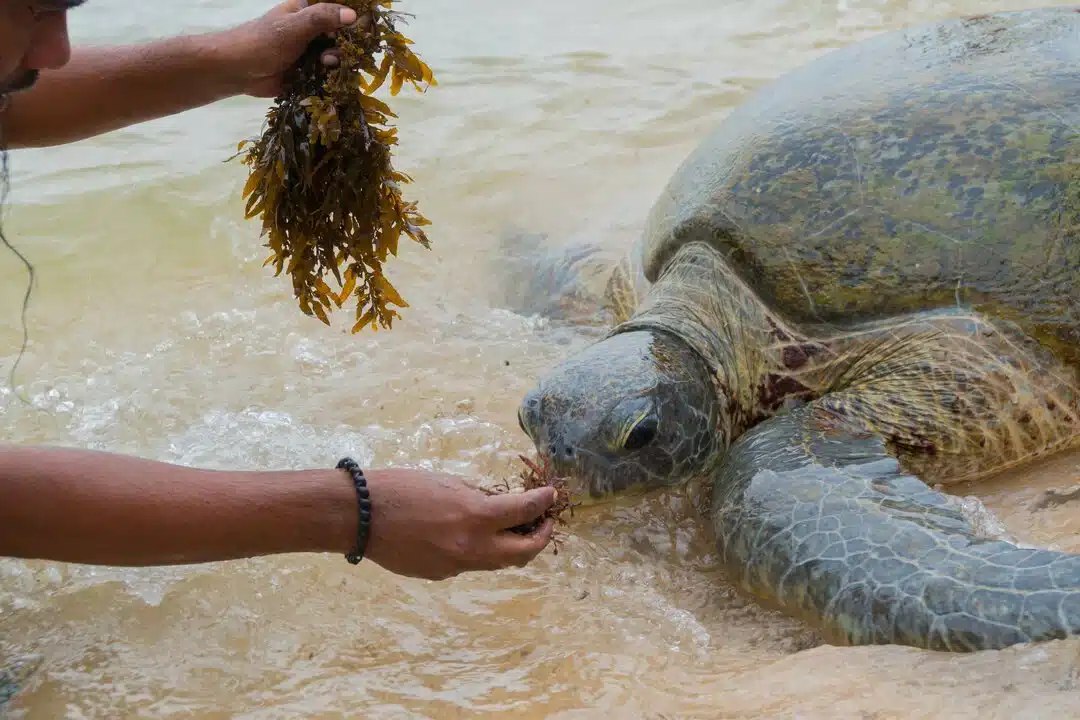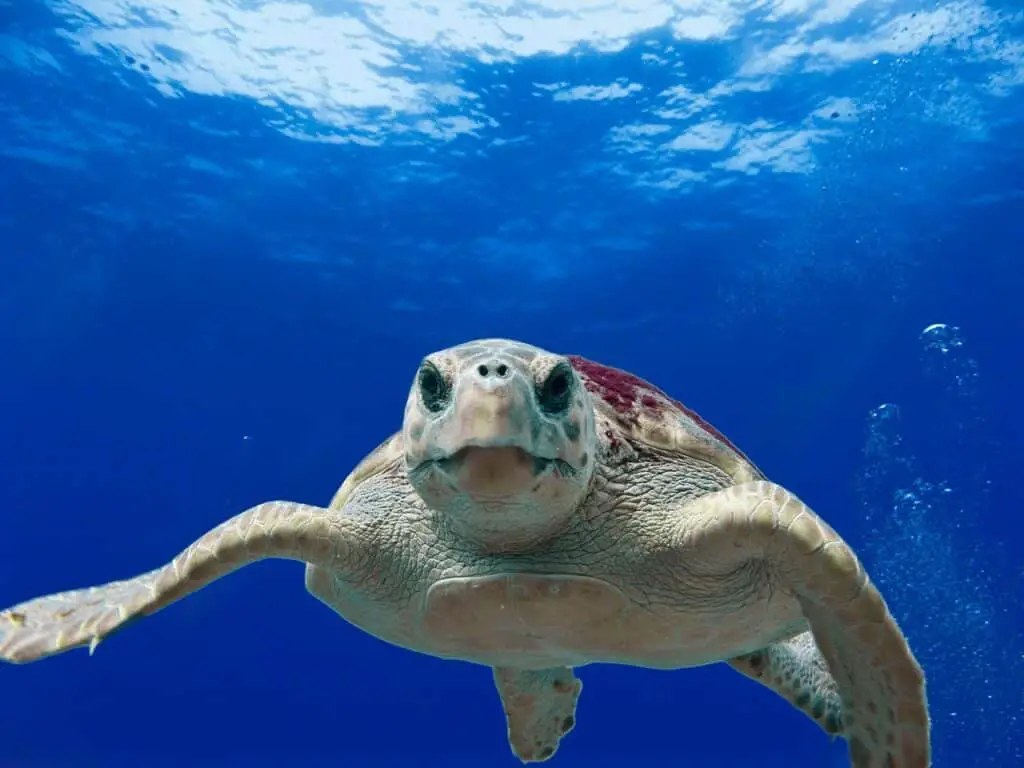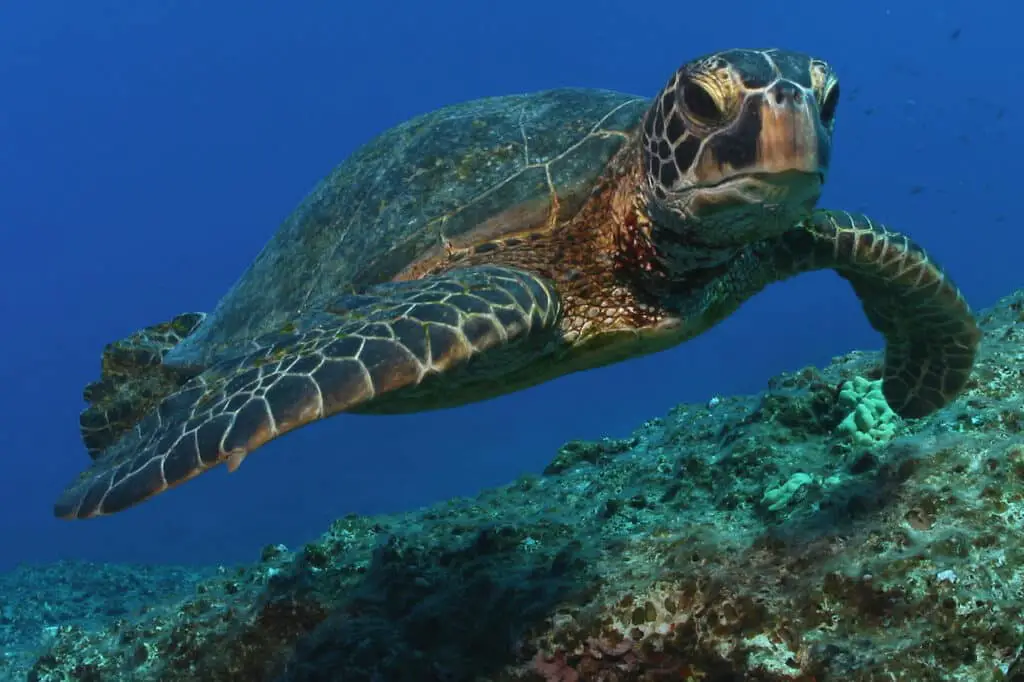Do Sea Turtles Bite

Introduction
Do Sea Turtles Bite: Sea turtles, these ancient and magnificent creatures of the oceans, have long been a subject of fascination and wonder. Their graceful movements through the water, the arduous journeys they undertake across vast distances, and their role in maintaining the delicate balance of marine ecosystems have captivated both scientists and nature enthusiasts alike.
This seemingly simple question opens the door to a complex world of behaviors, adaptations, and interactions that shed light on the lives of these enigmatic reptiles. Sea turtles are predominantly herbivores, feeding on seagrasses and algae. However, there are instances when they display territorial or defensive behaviors that might involve biting. Understanding the circumstances under which sea turtles bite, the reasons behind it, and the potential implications is essential for both their conservation and our appreciation of their natural history.
We will delve into the intriguing world of sea turtle behavior, examining the factors that lead to biting incidents, the species most likely to engage in this behavior, and the implications for their conservation. By unraveling the mystery of whether sea turtles bite, we can gain deeper insights into their ecology and contribute to the ongoing efforts to protect these magnificent creatures and the oceans they call home.

How strong is a sea turtle bite?
They have estimated that the bite force of the adult Loggerhead sea turtle is more than 500 pounds. It is enough to take off your finger.
A sea turtle’s bite may not be as formidable as that of a crocodile or a shark, but it still possesses surprising strength. The power of a sea turtle’s bite is primarily determined by its species and size. For instance, the largest sea turtle, the leatherback, has a beak-like jaw designed for consuming soft-bodied prey like jellyfish. While not suited for crushing, it can still exert significant force.
In contrast, species like the loggerhead and green sea turtle have more robust jaws adapted for crushing hard-shelled prey like crabs and mollusks. Their bite strength can be substantial, especially when considering the adaptations that have evolved over millions of years to facilitate their feeding habits.
However, it’s important to note that the strength of a sea turtle’s bite is relative to its intended diet. Their jaws have evolved to suit their preferred prey, and they are not designed for predatory aggression. They are primarily gentle herbivores or specialized feeders on soft-bodied creatures. Therefore, while a sea turtle’s bite may surprise some, it is not the defining feature of their behavior or ecological role in the marine ecosystem.
Does a turtle bite hurt?
Do their bites hurt? Yes, however, the severity of the bite depends a lot on the size and species of the tortoise or turtle. Do they only bite when they are hungry/curious? No, they can bite if they feel threatened.
Yes, a turtle bite can be painful, especially from certain species. While turtles are not typically aggressive and do not bite humans intentionally, they may bite if they feel threatened or cornered. Species like snapping turtles, for instance, are known for their powerful bites and sharp beaks, which can cause significant discomfort or even injury.
The pain experienced from a turtle bite can vary depending on the size and species of the turtle. Larger species, such as alligator snapping turtles, have more powerful bites and can potentially cause more severe injuries. Additionally, the location and depth of the bite also play a role in determining the level of pain.
It’s important to note that if bitten by a turtle, seeking medical attention is advised, especially if the skin is broken. Turtles inhabit various environments, including both freshwater and marine ecosystems, and their mouths may contain bacteria that can lead to infections if not properly treated.
Overall, while a turtle bite may not be on par with larger predators, it can still be a painful experience that warrants caution and proper care.
Do sea turtles have teeth?
Sea turtles do not have teeth to grasp their prey with, but instead, have very sharp beaks and strong jaws they use to crush their food. Every sea turtle also has stiff downward projections in their throats called papillae that prevent their meals from slipping back out of their mouth.
Sea turtles do not have teeth in the traditional sense. Instead, they possess specialized mouth structures adapted to their specific diets. The structure of a sea turtle’s mouth varies depending on its species and feeding habits.
For instance, the leatherback sea turtle, the largest of all sea turtle species, has a unique mouth with sharp, pointed cusps instead of teeth. This adaptation allows it to consume its preferred prey—soft-bodied creatures like jellyfish—with greater efficiency.
Other species like the loggerhead and green sea turtles have powerful, beak-like jaws. While they lack teeth, these jaws are well-suited for crushing and grinding hard-shelled prey such as crabs and mollusks. This adaptation enables them to feed on a diet rich in crustaceans and other creatures with protective shells.
Despite not having teeth, sea turtles are incredibly well-adapted to their respective feeding niches. Their mouth structures have evolved over millions of years to maximize their efficiency in capturing and consuming the types of food available in their marine environments. This remarkable adaptation is a testament to the intricacies of nature’s design.
Do sea turtles have sharp teeth?
The quick answer is no; sea turtles don’t have teeth.
Think of them as birds – they have beaks instead of teeth that they utilize to bite and chew their food. All turtles, including sea, freshwater, and even tortoises, lack teeth. These animals bite, tear, and chew with their powerful beaks rather than teeth.
Sea turtles do not have sharp teeth in the conventional sense. Instead, they possess specialized mouth structures that are adapted to their specific feeding habits. The mouth of a sea turtle varies depending on its species and the type of prey it consumes.
For example, the leatherback sea turtle, the largest of all sea turtles, has a unique structure in its mouth with pointed cusps. These cusps are not sharp in the way that traditional teeth are, but they serve a similar purpose. They enable the leatherback to grip and consume its preferred prey—soft-bodied creatures like jellyfish—with precision.
Other species like the loggerhead and green sea turtles have robust, beak-like jaws. While they lack individual teeth, the edges of their jaws are strong and well-suited for crushing and grinding hard-shelled prey such as crabs and mollusks. This adaptation allows them to feed on a diet rich in crustaceans and other creatures with protective shells.
While sea turtles do not have sharp teeth like some other marine predators, their mouths are uniquely adapted to their respective feeding niches. These adaptations showcase the incredible diversity of nature and how different species have evolved to thrive in their specific environments.
Will sea turtles hurt you?
A sea turtle is not an aggressive animal at all. Normally, they are docile creatures that only bite when threatened. A sea turtle bite is extremely rare and generally not dangerous.
Sea turtles are not aggressive creatures, and their primary defense mechanism is to swim away from potential threats. However, if they feel cornered, threatened, or mishandled, they may resort to defensive behaviors, which can include biting. While sea turtles lack sharp teeth, some species, like the loggerhead, have powerful jaws capable of causing discomfort or minor injuries.
It’s crucial to treat sea turtles with respect and observe them from a safe distance in their natural habitat. Interfering with or attempting to handle a wild sea turtle can cause stress and harm to the animal. Moreover, in many places, it is illegal and punishable by law to disturb or harm sea turtles, as they are protected species due to their vulnerable conservation status.
Like many aquatic creatures, sea turtles may harbor bacteria in their mouths that can lead to infections. Remember, the best way to appreciate and protect these magnificent creatures is by observing them responsibly and allowing them to thrive in their natural environment.
Are sea turtles aggressive?
By nature, sea turtles are not aggressive animals, although males during the mating season may display signs of territoriality and dominance, using their strong bite.
Sea turtles are not inherently aggressive creatures. Their natural behavior is generally peaceful and non-threatening. They are primarily solitary animals that spend the majority of their lives in the ocean, where they feed, migrate, and reproduce. When encountered in their natural habitat, sea turtles typically exhibit calm and non-confrontational behavior.
However, it’s important to note that like any wild animal, sea turtles may display defensive behaviors if they feel threatened or cornered. This can include attempts to swim away, retreat into their shells, or in rare cases, snapping or biting. The latter is a last-resort defense mechanism and is not typical behavior for sea turtles.
In situations where humans interact with sea turtles, such as during research, rescue, or rehabilitation efforts, it’s crucial to approach them with care and respect. Handling a sea turtle should be left to trained experts who understand their needs and behaviors to minimize stress and potential harm to the animal.
Overall, while sea turtles are not considered aggressive, it is essential to appreciate and observe them from a respectful distance to ensure their well-being and conservation.
How can I safely interact with sea turtles?
Interacting with sea turtles requires utmost care and respect for these protected creatures and their fragile habitats.
- Maintain a Safe Distance: Observe sea turtles from a respectful distance, preferably at least 10 feet away. Use binoculars or an underwater camera for close-up views without disturbing them.
- Avoid Direct Contact: Never attempt to touch, ride, or feed a wild sea turtle. This can cause stress, disrupt their natural behavior, and potentially harm them.
- Use Responsible Snorkeling and Diving Practices: If you’re snorkeling or diving, be mindful of your buoyancy to avoid accidentally touching or damaging coral reefs, which are crucial habitats for many species, including sea turtles.
- No Flash Photography: Flash photography can startle or disorient sea turtles. Use natural lighting or specialized underwater camera equipment to capture images without disturbing them.
- Respect Nesting Areas: If you encounter a nesting sea turtle or hatchlings, keep a safe distance and use only red or amber lights, which are less likely to disorient them.
- Dispose of Trash Properly: Reduce pollution by properly disposing of your trash, especially plastics. Marine debris poses a significant threat to sea turtles.
Remember, the best way to interact with sea turtles is to observe them in their natural environment without causing them any stress or harm. Respecting their space ensures that these magnificent creatures can thrive and contribute to the health of marine ecosystems.
Do sea turtles bite humans?
Sea turtles are not aggressive towards humans and do not intentionally bite. Their natural behavior is typically non-confrontational and focused on activities like feeding, migrating, and reproducing. However, there are rare instances where a sea turtle might bite a human, but this is usually a defensive response when the turtle feels threatened or cornered.
Species like the loggerhead have powerful jaws and, in certain situations, their bites can cause discomfort or minor injuries. It’s important to note that such situations are uncommon and typically occur when humans mishandle or provoke the turtle.
To avoid any potential risks, it’s crucial to observe sea turtles from a safe distance and never attempt to touch or approach them in the wild. Respecting their space and habitat is essential for both their well-being and your safety.
In the event that someone is bitten by a sea turtle, seeking medical attention is advised, especially if the skin is broken. While sea turtles are not known to carry harmful bacteria, there is still a risk of infection from any open wound.
Overall, while sea turtles are not considered aggressive towards humans, it is vital to treat them with care and respect to ensure their well-being and conservation.

Conclusion
Through our exploration, we’ve discovered that while sea turtles are primarily herbivores, there are indeed circumstances where biting occurs. Territorial disputes, mating interactions, and occasionally mistaking human objects for food can lead to these biting incidents.
Our investigation has emphasized the importance of understanding sea turtle behavior, not only for scientific curiosity but also for their conservation. As human activities increasingly impact marine environments, comprehending the nuances of sea turtle behavior becomes vital for their protection. By minimizing our disturbance of their habitats and reducing the prevalence of marine debris, we can mitigate the risks that lead to confrontations and biting incidents.
Our study highlights the need for continued research into sea turtle behavior to better inform conservation strategies. Protecting these magnificent creatures requires a holistic approach that encompasses habitat preservation, responsible human interaction, and global efforts to combat the threats they face, such as pollution and climate change.
Ultimately, the answer to whether sea turtles bite is not just a matter of curiosity but a reminder of our responsibility to safeguard these ancient mariners and the ecosystems turtles inhabit. By preserving their habitats and respecting their natural behaviors, we can ensure that sea turtles continue to grace our oceans for generations to come.



